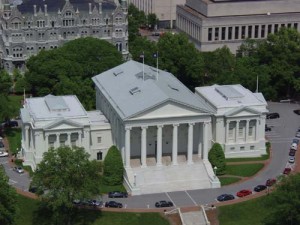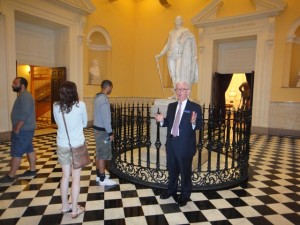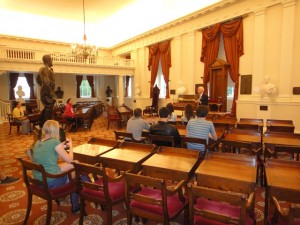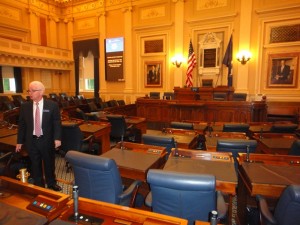 Over the past week, I’ve been chronicling my visit back to Virginia, where I’ve spent most of my adult life, and the tour I led for students. One more post about that, then I’ll get back to some commentary on the latest developments causing agitation in the nation’s capital. For today, I’d like to focus on Virginia’s capital, Richmond, and the Capitol at its center.
Over the past week, I’ve been chronicling my visit back to Virginia, where I’ve spent most of my adult life, and the tour I led for students. One more post about that, then I’ll get back to some commentary on the latest developments causing agitation in the nation’s capital. For today, I’d like to focus on Virginia’s capital, Richmond, and the Capitol at its center.
I didn’t take this photo, obviously, and was kept from taking any on the outside by the torrential rain we endured while walking in Richmond last Friday, thanks to the tropical storm that blanketed the east coast. But the rain couldn’t dampen the historical significance of this place.
 This capitol building opened for business in 1788, only seven years after Virginia’s capital moved from Williamsburg to Richmond. In its rotunda is a one-of-a-kind sculpture of George Washington. In 1785, renowned French sculptor Jean-Antoine Houdon arrived in the new United States for the express purpose of fashioning a lifelike statue of Washington. Houdon spent two weeks at Mt. Vernon where he measured Washington meticulously and made a life mask of his face. He then searched for the best white marble he could find, without any streaks of gray, and completed the statue, which was installed in the rotunda in 1796. This is the only life-sized statue of Washington in existence made directly from those measurements and life mask. When you look at this masterpiece, you are seeing the genuine George Washington in a way that no portrait can convey.
This capitol building opened for business in 1788, only seven years after Virginia’s capital moved from Williamsburg to Richmond. In its rotunda is a one-of-a-kind sculpture of George Washington. In 1785, renowned French sculptor Jean-Antoine Houdon arrived in the new United States for the express purpose of fashioning a lifelike statue of Washington. Houdon spent two weeks at Mt. Vernon where he measured Washington meticulously and made a life mask of his face. He then searched for the best white marble he could find, without any streaks of gray, and completed the statue, which was installed in the rotunda in 1796. This is the only life-sized statue of Washington in existence made directly from those measurements and life mask. When you look at this masterpiece, you are seeing the genuine George Washington in a way that no portrait can convey.
 We toured all the historic rooms on the main floor. One had a full wall painting of the storming of Redoubt #10 at Yorktown, the decisive assault that led to the victory there and the end of the American War for Continued Self-Government [a.k.a., the American Revolution for those who are unaware of my renaming fetish]. Then we entered the Jefferson room—pictured here—which is fitting, since Thomas Jefferson was the brains behind the Capitol’s architecture. What I didn’t realize until this tour is that the Virginia Capitol served as the site for the recent Steven Spielberg film Lincoln. I’ve seen the film but wasn’t aware this building was used for it. The guide said it took three months of filming; it also took a lot of work to cover up all modern additions—electric lights, newer portraits, etc., to give it the 1865 look and feel.
We toured all the historic rooms on the main floor. One had a full wall painting of the storming of Redoubt #10 at Yorktown, the decisive assault that led to the victory there and the end of the American War for Continued Self-Government [a.k.a., the American Revolution for those who are unaware of my renaming fetish]. Then we entered the Jefferson room—pictured here—which is fitting, since Thomas Jefferson was the brains behind the Capitol’s architecture. What I didn’t realize until this tour is that the Virginia Capitol served as the site for the recent Steven Spielberg film Lincoln. I’ve seen the film but wasn’t aware this building was used for it. The guide said it took three months of filming; it also took a lot of work to cover up all modern additions—electric lights, newer portraits, etc., to give it the 1865 look and feel.
 The old House of Delegates chamber is now used primarily for tours, but it has seen its lion’s share of historic moments. Nearly every Virginian associated with the first century of the state’s history has passed through this room. There are busts of Patrick Henry, John Marshall, George Wythe, and many others. At the center of the room, seen here on the left, is a large statue of Robert E. Lee, who refused Lincoln’s offer to command the Union armies and instead took control of Virginia’s state militia. The statue stands on the spot where he accepted that command. While I’m not a fan of the Confederate cause, one can still have respect for a man such as Lee, who was no advocate of slavery and acted as his conscience led him. I disagree with his decision, but cannot condemn the man himself.
The old House of Delegates chamber is now used primarily for tours, but it has seen its lion’s share of historic moments. Nearly every Virginian associated with the first century of the state’s history has passed through this room. There are busts of Patrick Henry, John Marshall, George Wythe, and many others. At the center of the room, seen here on the left, is a large statue of Robert E. Lee, who refused Lincoln’s offer to command the Union armies and instead took control of Virginia’s state militia. The statue stands on the spot where he accepted that command. While I’m not a fan of the Confederate cause, one can still have respect for a man such as Lee, who was no advocate of slavery and acted as his conscience led him. I disagree with his decision, but cannot condemn the man himself.
 Our final stop was in the current House chamber, which was used in the Lincoln movie as the stand-in for the U.S. House chamber. It’s kind of amazing how they were able to hide all the modern aspects such as microphones and buttons on the desks, as well as the electronic voting screens on the front wall. This is a beautiful room also. I really need to see Lincoln again to try to identify all the scenes that took place in the Capitol. It would be a nice exercise for me in particular since my first degree was in radio, tv, and film production—a marriage, in a sense, of that degree with my history doctorate.
Our final stop was in the current House chamber, which was used in the Lincoln movie as the stand-in for the U.S. House chamber. It’s kind of amazing how they were able to hide all the modern aspects such as microphones and buttons on the desks, as well as the electronic voting screens on the front wall. This is a beautiful room also. I really need to see Lincoln again to try to identify all the scenes that took place in the Capitol. It would be a nice exercise for me in particular since my first degree was in radio, tv, and film production—a marriage, in a sense, of that degree with my history doctorate.
We also visited the Museum of the Confederacy and the Confederate White House. At the museum, we listened to a fascinating account of how people in the Civil War era handled death and mourning, and all the beliefs and rituals associated with the loss of loved ones. At the White House, I could picture in my mind not only the reality of Jefferson Davis living there, but also the day Lincoln was able to walk into that house and rejoice that the long war he had overseen was about to conclude.
I always enjoy my trips back to the Old Dominion; the history is palpable everywhere. My students on this trip are not history majors, but I hope this time together sparked a lifelong interest in our American heritage.
